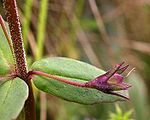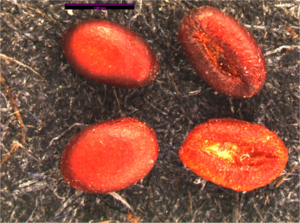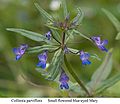Difference between revisions of "Collinsia parviflora"
(→Distribution) |
|||
| Line 20: | Line 20: | ||
==Distribution== | ==Distribution== | ||
| − | + | Occurs in BC extending south to California and east to Manitoba, Michigan, Colorado and Arizona (Pojar and MacKinnon, 1994; Ganders and Krause, 1986; Elle, 2002). | |
| + | |||
==Habitat== | ==Habitat== | ||
Rocky outcrops in coastal Douglas-fir zone. Areas that dry out rapidly in summer. Low to middle elevations but occasionally higher. Absent from the wet outer coast. | Rocky outcrops in coastal Douglas-fir zone. Areas that dry out rapidly in summer. Low to middle elevations but occasionally higher. Absent from the wet outer coast. | ||
Revision as of 12:37, 8 May 2012
Contents
Taxonomy
- Kingdom Plantae – Plants
- Subkingdom Tracheobionta – Vascular plants
- Superdivision Spermatophyta – Seed plants
- Division Magnoliophyta – Flowering plants
- Class Magnoliopsida – Dicotyledons
- Subclass Asteridae
- Order Scrophulariales
- Family Scrophulariaceae – Figwort family
- Genus Collinsia Nutt. – blue eyed Mary
- Species C. parviflora Lindl. – maiden blue eyed Mary
Description
Annual herb 5-40 cm tall from a taproot. Leafy stems usually erect of ascending, however, sometimes long and sprawling; may be simple or branched. Middle and upper leaves are opposite (or whorled), oblong to lance-shaped, 1-4 cm long, though smaller and bract-like in the inflorescence. Lower leaves are oblong to spoon-shaped and are stalked. Leaves are usually hairless while stems are often covered in minute hairs that may be glandular. Flowers are two-lipped, 4-8 mm long. The upper lip is white and two lobed; the lower lip is blue and three lobed; four stamens. Flowers are borne in the leaf axils on hairy stalks. Fruit is a smooth, reddish-brown capsule 3-5 mm long, football-shaped, usually bearing four seeds (Pojar and MacKinnon, 1994).
Bloom Period
April - June
Distribution
Occurs in BC extending south to California and east to Manitoba, Michigan, Colorado and Arizona (Pojar and MacKinnon, 1994; Ganders and Krause, 1986; Elle, 2002).
Habitat
Rocky outcrops in coastal Douglas-fir zone. Areas that dry out rapidly in summer. Low to middle elevations but occasionally higher. Absent from the wet outer coast.
Seed
Abbreviation: COPA
Seed sample from: 2011
Average measurement: 0.7 x 1.5 x 1
Measurement range: L: 0.5 - 0.9, W: 1.3 x 1.7, D: 0.9 x 1.3
Features
Color Seeds bright red with elliptical, white, large depression that is the hilium on a longer seed side.
Surface Seeds red, matte, and very slightly bumpy. Possibly smoother than COGR. Some seeds have seed coat ridges at the edge of the seed, giving it a somewhat winged look.
Seed slightly larger than Collinsia grandiflora.
Could be confused with: Collinsia grandiflora.
Latitudinal cross section: elliptical ![]()
Longitudinal cross section: irregular
Basic Explanations and Assumptions:
The dimensions for the seeds are length x width x depth. The location of the hilum is used as the base of the seed, and the length is measured from hilum to the opposite apex. Where a style is present, the length is measured from the hilum to the bottom of the style. Width is measured at a right angle to the length at the widest part. Depth is measured at a right angle to the intersection of height and width lines.
Measurements included are the mean average for each measurement of ten separate seeds.
All measurements in millimeters unless otherwise noted.






